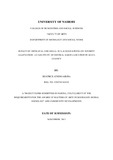| dc.description.abstract | The urgent demand for appropriate mitigation of the activities of Artisanal and Small-Scale Mining (ASM) in Africa has become necessary in view of the immense contribution of the mining activities to poverty alleviation in the continent. The specific objectives of this study were; to find out how the people of Central- Sakwa location have conceptualize ASM and poverty; to examine the extent in which ASM have alleviated poverty among the people of Central-Sakwa location; and to find out the factors that have promoted or inhibited ASM in alleviating poverty among the people of Central- Sakwa Location.
This study had two theories governing it and this were the resource – curse theory and the theories of poverty as well as a conceptual framework illustrating the link between ASM and poverty alleviation. Chapter three of this study focused on the research methodology setting out a descriptive study design with Household Survey, Focus Group Discussions (FGDs), Key Informant Interview, and observation as data collection methods used to generate primary data. Secondary data provided complementary information on the topic of study.
The analyzed data was presented using narrative reports and quantitative techniques of data such as Pie charts, tables, percentages and graphs. The findings of this study revealed that respondents had diversity on conceptualization of ASM and poverty. A good number of respondents did not understand the meaning of artisanal an indication that the problem of understanding ASM existed in Central-Sakwa location.
The study established that ASM had help gold miners to meet their needs but this was identified to be short term as it depended on the fluctuating income of the miners. From the findings, it was evident that with the illegality of the sector, there was no taxation of income from the activity hence no development projects directly associated with it in the location. The study found out that the main factors that had promoted ASM to alleviate poverty were; availability of ready market and the mineral gold within the location, and provision of food to casual laborers by the site managers while those that inhibited ASM from alleviating poverty included; accidents/deaths at the mines, lack of finance to invest on mining equipments and machines, political instability, and lack of skills on harvesting gold.
From the findings it was evident that with financial support, legalization of the sector, training of miners and putting measures on how to properly invest income from gold mining, would help ensure that ASM alleviates poverty among the community members of Central-Sakwa location. | en_US |

